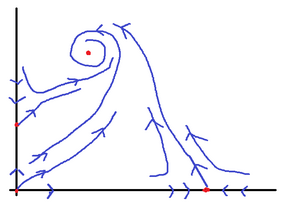We will need to analyze the linearized system at each critical point.
At (x,y) = (0,0)

which has eigenvectors  and
and  with corresponding eigenvalues 3 and 1 respectively. The local solution structure centred at (0,0) is
with corresponding eigenvalues 3 and 1 respectively. The local solution structure centred at (0,0) is

Along both eigenvectors, the trajectories move away, with the  direction being dominant, since it is multiplied by the larger term, e3t.
direction being dominant, since it is multiplied by the larger term, e3t.
At (x,y) = (0,1)

To find the eigenvector corresponding to  , we seek the solution to
, we seek the solution to  so that
so that

Or  , so we take
, so we take  .
.
To find the eigenvector corresponding to  , we seek the solution to
, we seek the solution to  so that
so that

Or v1 = 0, v2 = anything, so we take  .
.
The local solution structure centred at (0,1) is

The solution grows exponentially along the  direction and decays exponentially along the
direction and decays exponentially along the  direction. Starting anywhere other than along the
direction. Starting anywhere other than along the  vector, the solution will approach the
vector, the solution will approach the  vector.
vector.
At (x,y) = (3,0)

To find the eigenvector corresponding to  , we seek the solution to
, we seek the solution to  so that
so that

Or v2 = 0, v1 = anything, so we take  .
.
To find the eigenvector corresponding to  , we seek the solution to
, we seek the solution to  so that
so that

Or  , so we take
, so we take  .
.
The local solution structure centred at (3,0) is

The solution grows exponentially along the  direction and decays exponentially along the
direction and decays exponentially along the  direction. Starting anywhere other than along the
direction. Starting anywhere other than along the  vector, the solution will approach the
vector, the solution will approach the  vector.
vector.
At (x,y) = (1,2)
 , which as we saw in part (a) has complex eigenvalues with negative real part. By plugging in a point, say
, which as we saw in part (a) has complex eigenvalues with negative real part. By plugging in a point, say  into the local linear system we can determine the direction of the spiral.
into the local linear system we can determine the direction of the spiral.

which points up and to the left at (1,0). Therefore the spiral is counterclockwise.
This is all put together in the very rough global phase portrait.































